The Google Nexus 5X Review
by Brandon Chester on November 9, 2015 8:00 AM EST- Posted in
- Smartphones
- LG
- Mobile
- Android 6.0
- Nexus 5X
GPU Performance
CPU performance is one side of an SoC, while GPU performance is the other side. With two years of GPU development between the Nexus 5 and the 5X we're hopefully looking at a substantial uplift in GPU performance. Qualcomm's official figures peg Adreno 418 as 20% faster than Adreno 330 in graphics workloads. To characterize the Nexus 5X's performance during graphics workloads that are similar to those a 3D game would provide I've run it through our standard GPU-focused benchmarks. The first is 3DMark, followed by BaseMark X and GFXBench 3.0.

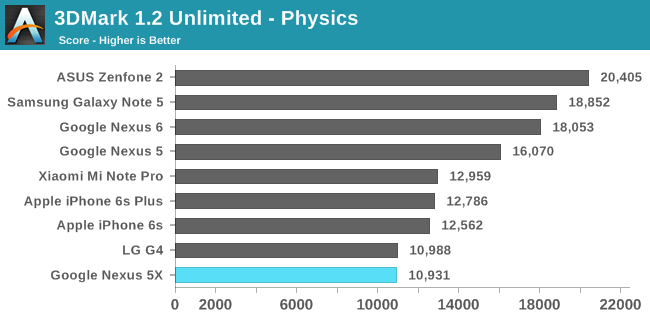
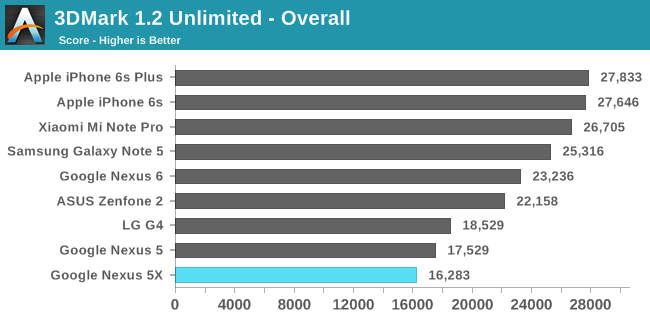
The Nexus 5X ends up actually coming in below the Nexus 5 in 3DMark's overall score. This is the result of the much lower score in the physics sub test. However, it's worth noting that the 3DMark physics test has heavy data dependencies and all of our tested devices with bigger out of order cores end up doing poorly. While this is a possible scenario in a real-world program, I wouldn't make too many conclusions from the Nexus 5X's performance here. In the graphics test there's actually a surprising gap between the 5X and the LG G4 which uses the same SoC, and I've been unable to get a score anywhere near it no matter how many times I re-run the test. At least in 3DMark it looks like the LG G4 has a bit of a lead over the Nexus 5X.
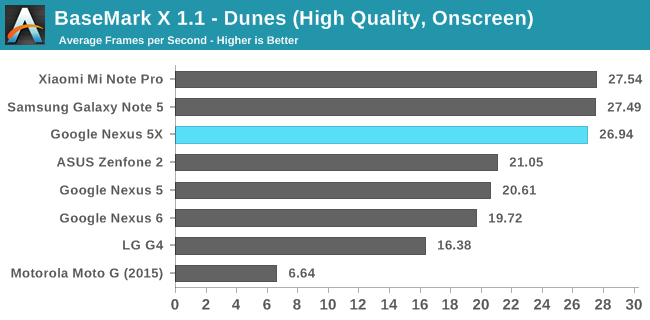
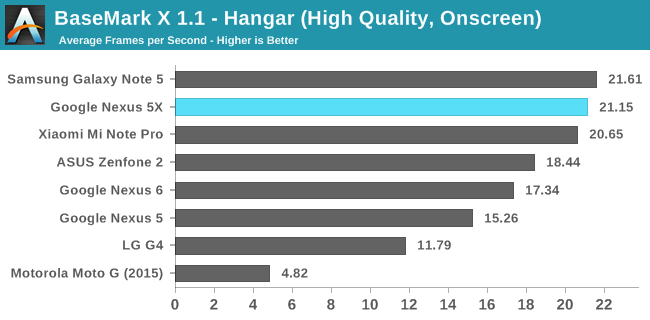
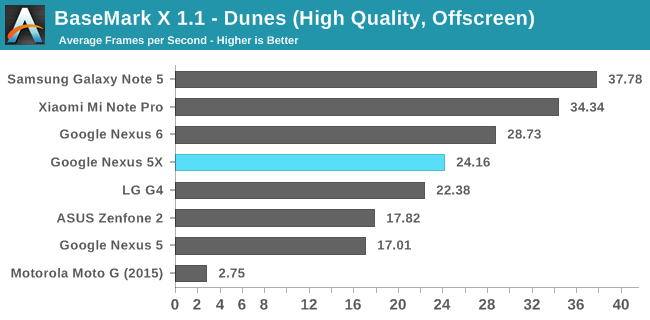
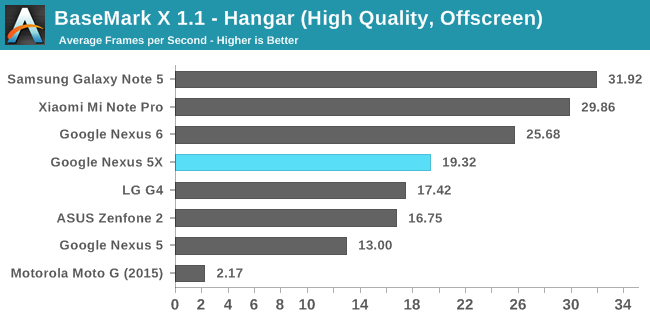
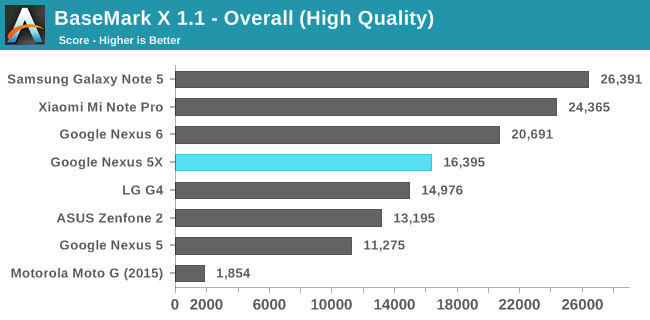
BaseMark X's results are more in line with what I expected to see from the 5X's GPU. The on-screen results are far ahead of the LG G4, which isn't surprising at all when you consider that the G4 is driving a 2560x1440 panel while the 5X is pushing 1920x1080. Both off-screen results are close enough that they could be ascribed to margin of error, and ultimately BaseMark X shows that there's not really any gap between the absolute performance of the G4 and the 5X, but the 5X will definitely be faster for anything running at native resolution.
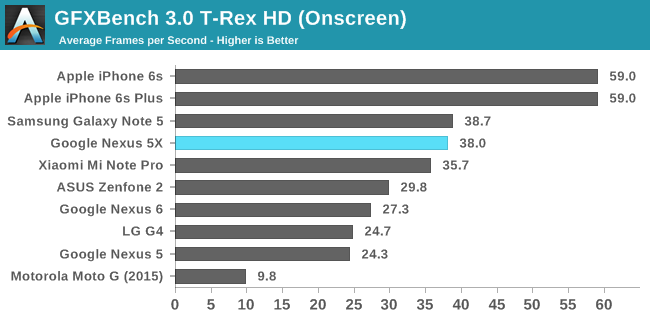
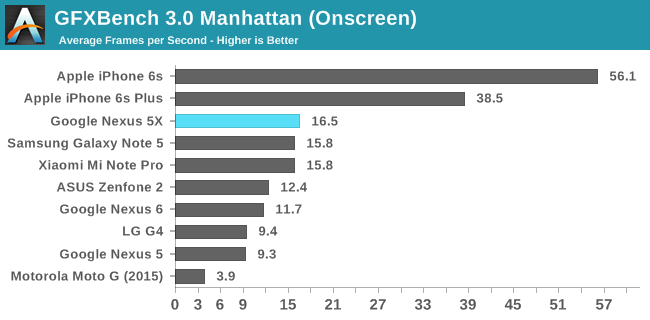

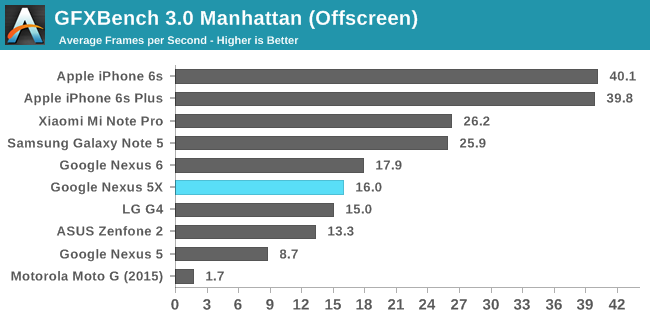
The results in GFXBench echo those of BaseMark X. The 5X beats the G4 in both off-screen cases, but only by a small margin. With the 5X being slightly faster than the G4 in both GFXBench and BaseMark X we may be looking at some small driver improvements here, but since all the gaps are so small it may just be coincidence that the 5X is the faster of the two devices in both tests.
Ultimately, both Adreno 418 and 430 are pretty good GPUs, and with the Nexus 5X being priced at $379 I think it offers more than adequate GPU performance for its price. What's interesting is that even though we didn't see Snapdragon 805 show up in many devices, it was in the Nexus 6, and its Adreno 420 GPU is definitely a bit faster than the Adreno 418 in the 5X. The Nexus 6 was also priced much higher than the 5X, and so with the 5X you're definitely getting a lot more GPU performance for your money than you got with the Nexus 6. The performance uplift is definitely greater than Qualcomm's stated 20%, and it's always nice to see something beat expectations.
NAND Performance
When I originally reviewed the Nexus 6 I decided to publish the review without any storage benchmarks, because in my testing I noticed that the results I was getting simply did not add up. Futher investigation revealed that it was the result of the Nexus 6's forced Full disk encryption (FDE), and the encryption and decryption of data being done without the use of high speed, power efficient fixed-function hardware. Later on in the Nexus 9 review Josh noted that there was a significant uplift in NAND performance compared to the Nexus 6, and it was clear that the AES/SHA instructions that are part of the ARMv8 instruction set were helping to reduce the performance impact of FDE.
Since Snapdragon 808 supports the ARMv8 ISA this presents a good opportunity to revisit this topic. The Nexus 5X shares several things with the LG G4, and one of them is its NAND, which is an eMMC 5.0 solution provided by Toshiba with the model number 032G74. While there's not much public information on this storage solution, one would expect that NAND storage speed results from the Nexus 5X closely match those of the LG G4, as if that isn't the case then it's clear that FDE causes a noticeable loss of performance despite ARMv8's cryptographic instructions.
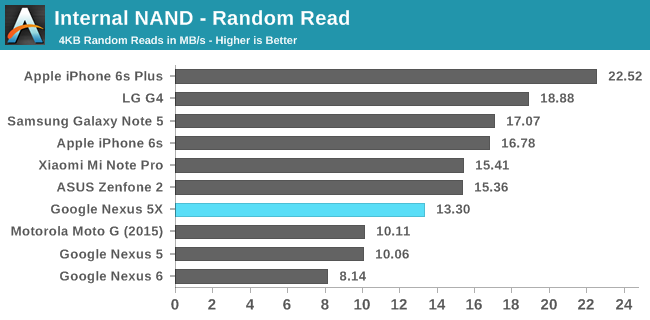
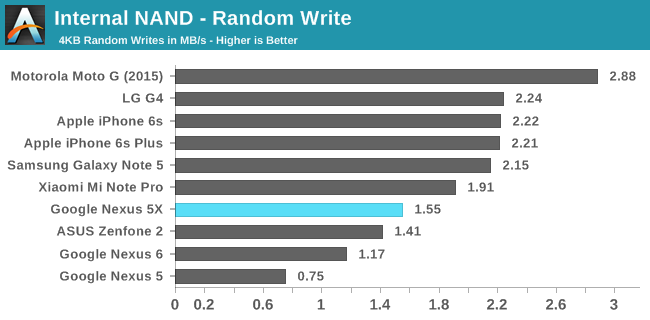
Random read and write speeds both take a hit when compared to the LG G4. While the gaps don't look enormous, the performance with small transaction sizes on mobile devices is hardly great to begin with, and so even these small gaps can matter greatly. In this case both random read and write speeds are both about 30% lower than the G4, which is significant.
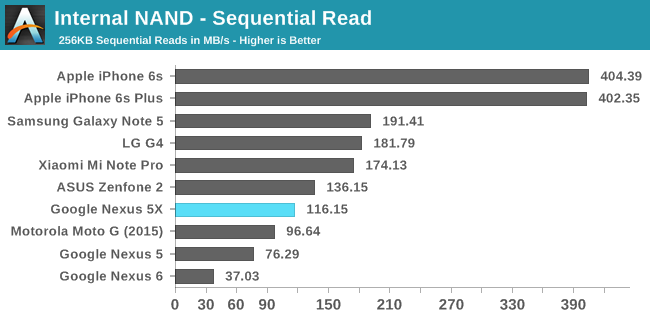
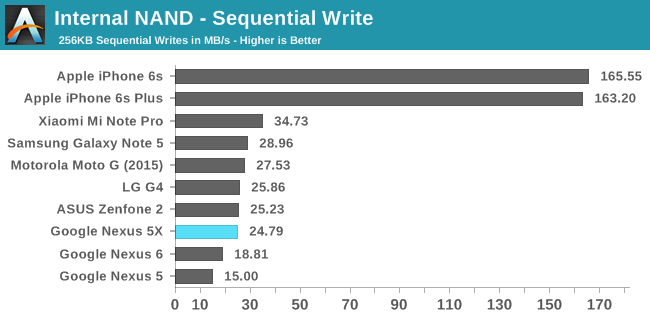
Sequential write speeds on the 5X end up being about equal to the G4, but the gap in sequential read speeds is enormous. Altogether, it's clear that there's still a significant reduction in NAND performance caused by the use of FDE when only using ARMv8's cryptographic instructions to encrypt and decrypt data to be written. This contrasts with comments made by Google engineer David Burke during a Reddit AMA discussing the FDE situation on the Nexus 5X in response to a comment that was referencing the Nexus 6's poor storage performance. What's interesting is that ARM has stated before that the ARMv8 cryptographic instructions are not a substitute for fixed-function hardware, and so it looks like there's a disagreement between ARM and Google on whether or not this is an adequate solution for encryption.
Reduced storage performance is not the only problem with this solution. Waking up the AP to do encryption or decryption every time the disk has to be read from or written to incurs a huge power penalty compared to simply using a hardware AES block and DMA which happens to be what Apple has been doing for about six years now. There are power savings here just waiting for Google to grab them, but they've decided not to do so for a second year now. Google certainly has an interest in getting Android phones to use FDE out of the box in order to combat negative perceptions about Android's security, but I don't think it's acceptable to have such a policy without the necessary hardware to make sure it doesn't affect the device's performance to any significant degree.
The Nexus 5X is certainly in a much better situation than the Nexus 6 was, but Google's FDE policy means you still get significantly reduced storage performance across the board compared to a device with the same NAND. This has various ramifications, ranging from data transfer speeds, to app install times, to performance when apps are updating in the background, to the ability to rapidly take photos and record high bitrate video. I really wish Google would either not ship with forced FDE and allow it to be disabled, or implement the necessary fixed-function AES hardware to avoid the significant performance hit.










197 Comments
View All Comments
kspirit - Monday, November 9, 2015 - link
Really impatiently waiting for an AT review of Moto X. It's either this or Moto X for me and I will *not* buy until I've got two AT reviews to compare.hans_ober - Monday, November 9, 2015 - link
I'd go with the 5X :)Main 'Nexus' concerns I've always had were camera and battery - which google has sorted out this time with the 5X.
3DoubleD - Monday, November 9, 2015 - link
Thankfully, I did not wait for Anandtech to review the Moto X Play, I just bought it.While I can't offer nearly the review dept of Anandtech, it is plenty fast for everything I've used it for (3D games, multitasking, browsing, ect.). It is a great phone. Similar price the the Nexus (although anecdote-ally, mine was cheaper at $399 - $50 Visa card - value of a 2nd Quick Charge charger - plus I didn't have to pay up front). The battery life is just unparalleled. Display looks great in all conditions. Good hand feel, but I got a case because I'm reckless sometimes. Call quality is excellent. Front speaker is plenty loud. Camera is OK, good in light, passable in low light. Motorola updates Android slightly slower than the Nexus phones, but barely. Android is stock. Has an microSD slot. Wifi reception is great in my experience. Does NOT have a notification LED, but has the low power on screen notification system that works fine (although deep down I slightly miss the LED).
Mainly, compared to the Nexus 5X you are sacrificing the slightest amount of real world SoC performance for more battery life and an SD card slot. The screen on the Moto X Play is also slightly bigger. Either way, you'd probably be happy.
3DoubleD - Monday, November 9, 2015 - link
I should add that you also forgo the fingerprint scanner with the Moto X Play versus the Nexus 5X. The importance of this feature depends whether you think mobile phone payment will catch on where you live. I would be incredibly surprised if it was widely adopted where I live (Canada) over the next 2 years.Bob Todd - Monday, November 9, 2015 - link
The fingerprint scanner becomes a sanity saving mechanism when you have unlocked your gadget for the billionth time and realize you are totally sick of doing so. Why would you think it is only important to payments? Integration with password software is also huge. I logged into this site with my fingerprint...erple2 - Monday, November 9, 2015 - link
This! I think that the fingerprint sensor is going to become a defacto replacement for entering your password in to your phone (for better or worse), but I'm all for it. Entering a 15 digit password with upper/lower case, numbers and special characters is a pain on a smartphone. If that can be circumvented with the (admittedly great) fingerprint sensor (I have a 5X), then I'm all for it.Bob Todd - Monday, November 9, 2015 - link
Most people that think they aren't a big deal usually haven't gotten to use a good one for any extended amount of time. I had one of the first Android devices with a fingerprint sensor (Motorola Atrix). That sensor was garbage compared to what's available today and I wouldn't pay an extra penny to have one like that included on a phone. Sensors like what Apple has been putting out or what's in these Nexus devices? They are absolutely one of the biggest changes to the entire user experience for anyone who is on their phone for whatever reason throughout the day. I'd easily pay over $100 just for a good fingerprint sensor. I contemplated a Moto X Pure but just couldn't do it because of that omission alone. My work phones were iPhones, and when I got my iPhone 6 it made me loathe anything on my personal phone that required a PIN or password. I could never go back to a phone without some kind of streamlined biometric login.twizzlebizzle22 - Monday, November 9, 2015 - link
Not sure on the test but my Nexus 6P NAND seems pretty quick when running androbench. Even for an encrypted device.Glock24 - Monday, November 9, 2015 - link
It does not seem like a good value, especially considering the limited storage options and no SD slot. 2GB RAM seem limited too.Bob Todd - Monday, November 9, 2015 - link
I think the biggest problem with this phone is that it doesn't seem like a good value compared to the 6P. Google made it really hard to choose the 5X.The "small" Nexus is still large at 5.2". They need more than half an inch separating the phones. This one should have been 4.7".
There's only a $70 difference for equivalent capacities. Which is really about $60 when you realize the 5X doesn't come with an A-> C cable but the 6P does.
The 6P has great front facing stereo speakers. The 6P has a more capable camera system (e.g. burst and 240fps slow motion). The 6P has a premium build. The 6P has 3GB of RAM. The 6P has a higher resolution display (I think over 1080p is overkill on a phone, but it impacts the BOM). The 6P has the (theoretically) better SOC. The list goes on.
You are giving up a lot for a small price advantage, at least based on US prices. If the "small" Nexus was actually reasonably compact I think it would fill a more important niche. With both being big ass phones, the decision to go for the 6P was easy to make.